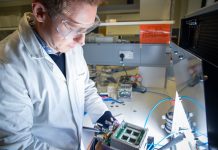
A team of researchers has discovered a groundbreaking way to recover rare earth elements (REEs) using waste eggshells, potentially revolutionizing the way we source materials essential for green energy technologies.
Their findings, published in the journal ACS Omega, offer a sustainable and environmentally friendly method for extracting REEs, which are crucial for technologies like electric cars and wind turbines.
The research team, from Trinity College Dublin’s School of Natural Sciences and the Ireland Research Centre in Applied Geosciences (iCRAG), explored the potential of using calcium carbonate (calcite) found in eggshells to absorb and separate REEs from water.
Given the increasing demand and limited supply of REEs, finding sustainable extraction methods is vital, as current methods are often harmful to the environment.
The researchers tested eggshells in solutions containing REEs at various temperatures, ranging from a comfortable 25°C to a scorching 205°C, over periods of up to three months.
They discovered that REEs could enter the eggshells through diffusion along the calcite boundaries and the organic matrix.
At higher temperatures, new minerals formed on the eggshell surface.
At 90°C, the eggshell surface helped form a rare earth compound called kozoite. As temperatures increased, the calcite in the eggshells dissolved and was replaced by polycrystalline kozoite.
At the highest temperature of 205°C, this mineral gradually transitioned into bastnasite, a stable rare earth carbonate mineral used in industry to extract REEs for technological applications.
This innovative method suggests that waste eggshells could be repurposed as a low-cost, eco-friendly material to help meet the growing demand for REEs. Over time, the eggshells trap distinct rare earths within their structure, making them an effective tool for sustainable extraction.
Lead author Dr. Remi Rateau highlighted the significance of this discovery, stating, “This study presents a potential innovative use of waste material that not only offers a sustainable solution to the problem of rare earth element recovery but also aligns with the principles of circular economy and waste valorization.”
Principal Investigator Prof. Juan Diego Rodriguez-Blanco emphasized the broader implications of the findings, adding, “By transforming eggshell waste into a valuable resource for rare earth recovery, we address critical environmental concerns associated with traditional extraction methods and contribute to the development of greener technologies.”
In summary, the research shows that waste eggshells can be turned into a valuable resource for recovering rare earth elements.
This approach not only helps meet the growing demand for REEs in an eco-friendly way but also supports the principles of a circular economy by repurposing waste material.



